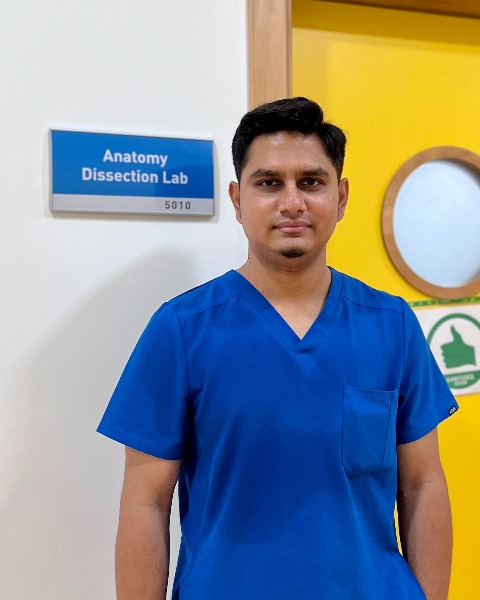Upper Limb Case & Anatomical Studies Posters
Poster: Upper Limb Case & Anatomical Studies Posters
62 - Variations in the Extensor Digitorum Communis Muscle Tendon in the Burmese Population: Implications for Hand Reconstructive Surgery
Sunday, March 24, 2024
5:00pm - 7:00pm US EDT
Location: Sheraton Hall
Poster Board Number: 62
There are separate poster presentation times for odd and even posters.
Odd poster #s – first hour
Even poster #s – second hour
Co-authors:
There are separate poster presentation times for odd and even posters.
Odd poster #s – first hour
Even poster #s – second hour
Co-authors:
Than Than Win - Professor, Department of Anatomy, University of Medicine-1, Yangon; Tin Moe Nwe - Associate Professor, Faculty of Medicine, UNIVERSITI KUALA LUMPUR Royal College of Medicine Perak; Soe Lwin - Associate Professor, Faculty of Medicine, UNIVERSITI KUALA LUMPUR Royal College of Medicine Perak

ZAW MYO HEIN, MBBS, PhD
Assistant Professor
College of Medicine, Ajman University
Ajman, Ajman, United Arab Emirates
Presenting Author(s)
Abstract Body : Variations of the extensor digitorum communis muscle tendon in the Burmese population; implications for hand reconstructive surgery
Introduction
Wrist and hand extensor tendon injuries are common due to their less protected anatomical location. Awareness of the anatomical variations of the extensor tendons of the hand is crucial in assessing the traumatized or diseased hands. The extensor digitorum communis (EDC) muscle tendon is one of the valuable tendons used for tendon grafting. The current study aims to describe the prevalence of anatomical variations of the EDC in the Burmese population.
Materials and Methods
A total of 64 upper limbs from 32 cadavers of both sexes were dissected in this descriptive cross-sectional study. Ethical clearance for the study was granted by the Board of Ethical and Research Committee, University of Medicine 1, Yangon, Myanmar. All autopsies were examined after obtaining informed consent from the next of kin. The age of the individuals ranged from 23-75 years. Cases with unilateral or bilateral limb deformities, forearm and hand injuries and evidence of surgical interventions to the forearm and hand were excluded from the study.
Results
In this study, various types of EDC muscle tendon to medial four fingers (EDC-Index, EDC-Middle, EDC-Ring and EDC-Little) were observed. Only single EDC tendon type was present in index fingers. In middle and ring fingers, single EDC tendon, double EDC tendon, triple EDC tendon types were found. In addition, a quadruple tendon type was observed in ring fingers. In little fingers, absent EDC tendon, single EDC tendon, and double EDC tendon types were reported. The prevalence of single EDC-Index tendon was 100% (64 hands), single EDC-Middle tendon 51.6% (33 hands), double EDC-Middle tendon 37.5% (24 hands), triple EDC-Middle tendon 10.9% (7 hands), single EDC-Ring tendon 9.4% (6 hands), double EDC-Ring tendon 50% (32 hands), triple EDC-Ring tendon 35.9% (23 hands), quadruple EDC-Ring tendon 4.7% (3 hands), absent EDC-Little tendon 60.9% (39 hands), single EDC-Little tendon 34.4% (22 hands) and double EDC-Little tendon 4.7% (3 hands).
Conclusion
Knowledge of possible anatomical variations of the ECD tendon is vital to prevent misdiagnosis and mismanagement of traumatic injuries and other clinical problems of the dorsum of the hand such as ganglion, soft tissue tumour and tendosynovitis. Studies on anatomical variations in different populations are important since the newly discovered variant patterns may apprise population-specific variations and improve surgical outcomes.
Keywords: Anatomical variations; Extensor digitorum communis; Autograft; Tendon injuries; Burmese population.
Introduction
Wrist and hand extensor tendon injuries are common due to their less protected anatomical location. Awareness of the anatomical variations of the extensor tendons of the hand is crucial in assessing the traumatized or diseased hands. The extensor digitorum communis (EDC) muscle tendon is one of the valuable tendons used for tendon grafting. The current study aims to describe the prevalence of anatomical variations of the EDC in the Burmese population.
Materials and Methods
A total of 64 upper limbs from 32 cadavers of both sexes were dissected in this descriptive cross-sectional study. Ethical clearance for the study was granted by the Board of Ethical and Research Committee, University of Medicine 1, Yangon, Myanmar. All autopsies were examined after obtaining informed consent from the next of kin. The age of the individuals ranged from 23-75 years. Cases with unilateral or bilateral limb deformities, forearm and hand injuries and evidence of surgical interventions to the forearm and hand were excluded from the study.
Results
In this study, various types of EDC muscle tendon to medial four fingers (EDC-Index, EDC-Middle, EDC-Ring and EDC-Little) were observed. Only single EDC tendon type was present in index fingers. In middle and ring fingers, single EDC tendon, double EDC tendon, triple EDC tendon types were found. In addition, a quadruple tendon type was observed in ring fingers. In little fingers, absent EDC tendon, single EDC tendon, and double EDC tendon types were reported. The prevalence of single EDC-Index tendon was 100% (64 hands), single EDC-Middle tendon 51.6% (33 hands), double EDC-Middle tendon 37.5% (24 hands), triple EDC-Middle tendon 10.9% (7 hands), single EDC-Ring tendon 9.4% (6 hands), double EDC-Ring tendon 50% (32 hands), triple EDC-Ring tendon 35.9% (23 hands), quadruple EDC-Ring tendon 4.7% (3 hands), absent EDC-Little tendon 60.9% (39 hands), single EDC-Little tendon 34.4% (22 hands) and double EDC-Little tendon 4.7% (3 hands).
Conclusion
Knowledge of possible anatomical variations of the ECD tendon is vital to prevent misdiagnosis and mismanagement of traumatic injuries and other clinical problems of the dorsum of the hand such as ganglion, soft tissue tumour and tendosynovitis. Studies on anatomical variations in different populations are important since the newly discovered variant patterns may apprise population-specific variations and improve surgical outcomes.
Keywords: Anatomical variations; Extensor digitorum communis; Autograft; Tendon injuries; Burmese population.

